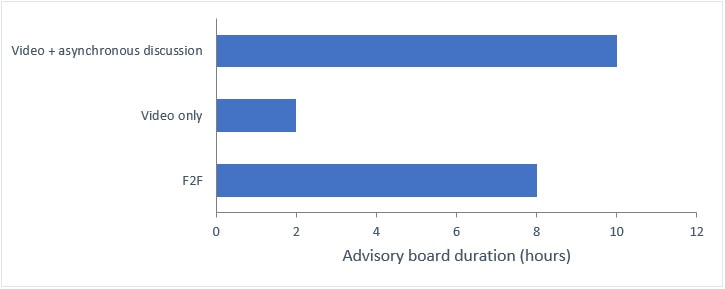Virtual advisory boards: what pharma learned in 2020 and new trends for the Post-COVID Era

Author: Natalia Denisova, PhD
VP, Head of Medical Affairs, MphaR
2020 was the year the COVID-19 pandemic started. The pandemic has influenced every aspect of the personal and professional lives of every person on the planet. Travel restrictions and social distancing have prevented key opinion leaders (KOLs) and other healthcare professionals (HCPs) meeting face-to-face (F2F). Pharmaceutical companies rely on annual advisory board meetings for strategic input and insights and strengthening relationships with KOLs. In this article, I’d like to focus on how Medical Affairs teams in the pharmaceutical industry have adapted to meet the challenges presented by this new environment.
MphaR, as one of the leading companies providing digital solutions to run virtual advisory boards, was involved from the beginning of this transformation. The MphaR team has led the education of Medical Affairs professionals across the globe, providing varying levels of support to pharmaceutical companies, according to their needs, to help them run their advisory boards in a digital format.
Let’s look at how practice has changed over the last year and feedback from participants of advisory boards.
KOLs and other HCPs are ready to participate in advisory boards using a digital format
In January 2019, MphaR conducted a survey1 in which we asked advisory board participants (KOLs and other HCPs) about their readiness to participate in virtual advisory boards. All (100%) respondents indicated that they were ready to participate in advisory boards using a digital format, despite only 8% having had prior experience of advisory boards in a digital format.
As a result of the pandemic, the percentage of KOLs and HCPs involved in advisory boards in a digital format increased dramatically in 2020 (Figure 1), a trend which has continued in 2021.

F2F, face-to-face; HCP, healthcare provider; KOL, key opinion leader
We conducted another survey in January 2021 to try to identify trends among HCPs after one year’s experience of participating in virtual advisory boards.2 We found that 1 in 2 respondents believed that participating in asynchronous discussion forums, where they could engage with the content in their own time and take as much time as they need to think about and answer the pharmaceutical company’s questions, as well as having access to all relevant publications and e-Library needed in order to provide qualitative feedback, would be more than sufficient for future advisory boards. Only 10% of respondents indicated that they would prefer to return to F2F interactions in the future (Figure 2).2

F2F, face-to-face; KOL, key opinion leader
Our analysis clearly demonstrates that HCPs are adapting rapidly to new methods of communication, including the use of digital platforms. They appreciate the convenience of digital platforms, their easy-to-use format, and the lack of a requirement for travel, which increases their time in the clinic and frees up their personal time.
MphaR’s Virtual Advisory Board Platform achieves an outstanding level of physician satisfaction
It is crucial for Medical Affairs personnel to evaluate the feedback provided by advisory board participants regarding the use of digital solutions, in order to identify future directions and improve future meetings. We measured the level of satisfaction with MphaR’s unique Virtual Advisory Board Platform using the Net Promoter Score (NPS®). The MphaR Virtual Advisory Board Platform achieved a NPS of 96%, which represents an extremely high level of physician satisfaction.
Medical Affairs teams have adapted quickly
We also analysed the ways in which Medical Affairs teams adapted their activities after March 2020.3 From April to June 2020, more than 60% of planned advisory boards were cancelled or rescheduled for Q3–Q4 2020. From July 2020, when it had become clear that the pandemic was not going to be resolved as quickly as we had initially hoped, Medical Affairs teams started to explore new digital solutions which would allow them to continue to execute advisory boards. By Q3–Q4 2020, 95% of advisory boards were organized in video conference format, using a range of online meeting platforms, such as Zoom, Microsoft Teams or GoToMeeting.3
While running advisory boards in video conference only format represents an easier option for Medical Affairs personnel, and the attendance rate is improved versus the F2F format, there is a significant drop in the level of insights received during video conference only meetings (Figure 3). This is driven by several factors, including the duration of the video conference (Figure 4) – it can be difficult to keep advisors engaged for more than 2 hours of video conferencing.

F2F, face-to-face

F2F, face-to-face
While there was a clear trend for moving from traditional F2F advisory boards to a virtual format in 2020, the quality of interactions significantly decreased. The results of our survey suggest that a combination of video interaction and asynchronous discussion forum allows companies to collect considerably more insights compared with a F2F or video conference only format.3
To maximise meeting success, Medical Affairs personnel must be trained, to ensure that they fully understand the technology. In our experience, it takes approximately 5–6 months for a Medical Affairs team to be fully trained in how to utilize the full potential of digital advisory boards.
A virtual format provides a more efficient and cost-effective way of running advisory boards
In conclusion, a virtual format has proven to be a more efficient, easier and cost-effective way of running advisory boards compared with the traditional F2F format. A combination of video interaction and asynchronous discussion permits the collection of more insights than any other format of interaction. Importantly, 50% of HCPs surveyed2 would prefer to utilize only an asynchronous format of interaction while participating in advisory boards in the Post-COVID-19 world.
- MASS Newsletter, Philadelphia, US, April, 2019; MphaR Survey, January 2019.
- MphaR Survey: analysis of 300 HCPs, January 2021.
- MphaR Survey: analysis of 200 Medical Affairs representatives, December 2020.




